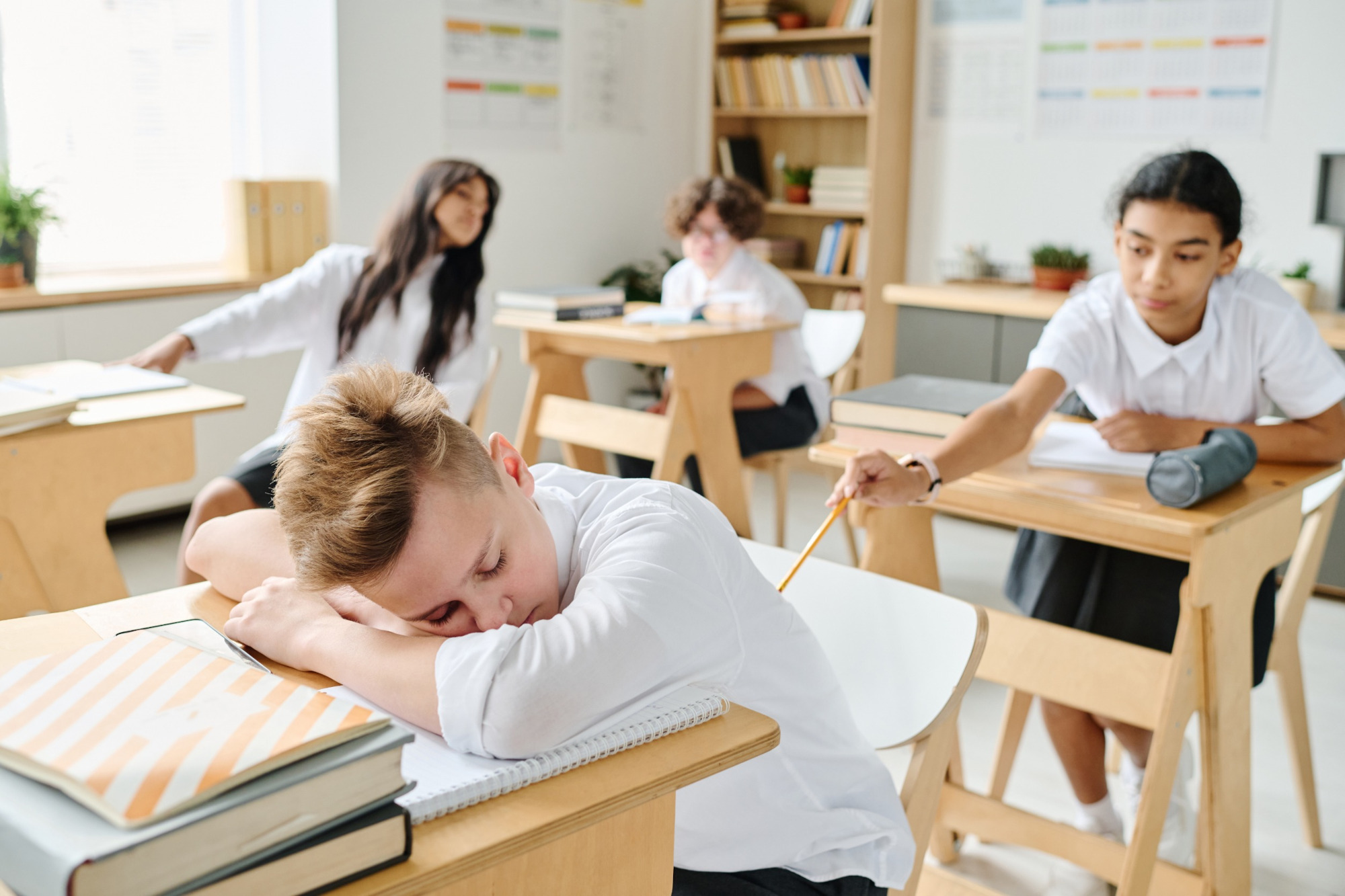Why Later School Times
Later school times benefit students of all ages from kindergarten to college, according to multiple trusted and relevant sources. Yet, why are later school times being discussed and debated? Well according to the CDC, the majority of our children are not getting the recommended 9-10 hours of sleep, especially during the school year. When the school schedule (of start times before 8:30am) nationally was studied, the early school times were found to contributing to this sleep deficit. How so?
- Over 10% of U.S. high schools currently start before 7:30 a.m., 43% start before 8 a.m., and under 15% start after 8:30 a.m.
- Over 20% of U.S. middle schools start class at 7:45 a.m. or earlier.
- Bus pick-ups start as early as 5 a.m. in some districts, and teens must wake at 5 or 6 a.m. to get to school on time.
- The school day ends around 2-3 p.m., on average and then there is homework, sports, and extracurricular activities … all leading to a huge sleep debt for our teens and school-aged children.
- And this schedule does not account for many adolescents, teenagers and young adults who stay up late to play online games, text or talk with friends, browse the internet, and use social media.
How does later school times affect students of all ages, according to statistics and nationally recognized medical organizations? Which states have changed school start times and what benefits have they seen? And what are the pros and cons of later school times?
Later School Times Statistics & Studies
- WHO RECOMMENDS: The American Academy of Pediatrics, Centers for Disease Control and Prevention, and American Medical Association all recommend that middle and high schools start class no earlier than 8:30 a.m. to allow students to get healthy sleep.
- EARLY TIMES: More than 4 in 5 (82.3%) of U.S. middle, high, and combined public schools require students to attend class at times earlier than the recommended time of 8:30am.
- FALLING ASLEEP: In the National Sleep Foundation poll cited previously, 28% of students reported falling asleep in school at least once a week, and more than 1 in 5 fell asleep doing homework with similar frequency. And 20-30% of high school students and 6% of middle school students fall asleep in school each day.
- PROVEN BENEFITS: When schools have delayed the start of the school day, communities have seen reduced tardiness, sleeping in class, and car crash rates, as well as improved attendance, graduation rates, and standardized test scores
- REDUCED RISK: A major, multi-state study conducted by researchers at the University of Minnesota and the U.S. Centers for Disease Control and Prevention linked later high school start times to significant decreases in teen substance abuse, depression, and consumption of caffeinated drinks.
- COST SAVINGS: The Brookings report also estimated that later high school start times create a lifetime earnings gain of $17,500 per student with a school system cost of $0.00 to $1,950 per student, a benefit-to-cost ratio of 9:1 or better.
Reference: https://www.startschoollater.net/wake-up-calls-fast-facts.html
What a Sleep Physician Says about Later School Times
Dr. Mark Rasmus M.D., of Everything Sleep Idaho, is a sleep physician dedicated to public education about sleep matters. He carefully reviewed the research and studies, both for and against, before coming to this conclusion:
“In my opinion, delaying school start times in middle and high school aged students is the lowest hanging fruit in regards to improving mental health and performance for our students. The science behind making the change is concrete and the data clearly shows that it is cost effective over the long run.” – Mark Rasmus, M.D., Medical Director of Everything Sleep Idaho
What the American Academy of Sleep Medicine says about Later School Times
“Based on the available evidence, the AASM calls on primary academic institutions, school boards, parents, and policymakers to raise public awareness and improve education in order to promote a national standard of middle school and high school start times of 8:30 a.m. or later. The AASM also encourages a collaborative and participatory approach among all stakeholders to support school boards as they overcome a variety of real and perceived barriers to the implementation of delayed school start times.” – AASM, 2017
(Link to: https://aasm.org/sleep-advocacy-in-action-shaping-the-future-of-school-start-times/)
What the American Psychological Association says about Later School Times
“Numerous studies have been done with schools that have shifted to later start times; while individual differences in communities and research methodology have led to different outcomes, results are almost always positive. Benefits observed from later high school start times include: Increased attendance rates; decrease in disciplinary action; Decrease in student-involved car accidents; Increase in student GPA; Increase in state assessment scores; Increase in college admissions test scores; Increase in student attention; Decrease in student sleeping during instruction; Increase in quality of student-family interaction.”
What the American Academy of Pediatrics says on Later School Times
“The American Academy of Pediatrics recognizes insufficient sleep in adolescents as an important public health issue that significantly affects the health and safety, as well as the academic success, of our nation’s middle and high school students. The American Academy of Pediatrics lends its strong support to school districts contemplating delaying school start times as a means of optimizing sleep and alertness in the learning environment and encourages all school administrators and other stakeholders in communities around the country to review the scientific evidence regarding school start times, to initiate discussions on this issue, and to systematically evaluate the community-wide impact of these changes (eg, on academic performance, school budget, traffic patterns, teacher retention).” – AAP, 2014
(Link to: https://publications.aap.org/pediatrics/article/134/3/642/74175/School-Start-Times-for-Adolescents)
What the Center for Disease Control say about Later School Times
“The combination of late bedtimes and early school start times results in most adolescents not getting enough sleep. In recent years, evidence has accumulated that later school start times for adolescents result in more students getting enough sleep. School districts can support adequate sleep among students by implementing delayed school start times as recommended by the American Academy of Pediatrics (AAP), the American Medical Association, and the American Academy of Sleep Medicine.” – CDC, 2023
(Link to: https://www.cdc.gov/healthyschools/sleep.htm)

What States have Enacted Later School Times
State policymakers have different perspectives on a wide range of issues, but there’s one that unites their legislatures and governors. Establishing safe, healthy, and developmentally appropriate school hours is a bipartisan effort; mainly because the extraordinary and proven benefits of healthy school start times transcend party lines and political landscapes.
Thanks to public support of organizations like AASM, the American Academy of Pediatrics, CDC, and the American Association of Sleep Technologists, recognition of the need for healthy school hours continues to gain steam, with many states considering statewide regulations to help ensure sleep-friendly school start times:
| Pending State Legislation | Passed Legislation |
| Connecticut | California |
| Hawaii | Connecticut |
| Louisiana | Florida |
| Maine | Indiana |
| Massachusetts | Maryland |
| Nevada | New Mexico |
| New York | New Jersey |
| Oregon | Pennsylvania |
| Pennsylvania | Utah |
| Texas | |
| West Virginia | |
| Oregon |
The benefits are clearly seen from studies on delayed start times in schools and districts across the country in Colorado, Connecticut, Kentucky, Minnesota, Missouri, Rhode Island, Virginia, & Wyoming, including urban, rural, and suburban environments.
What are the Pros and Cons of Later School Times
PRO: School-aged children who get consistent, adequate and quality sleep are less tired and can learn at their best. On the other hand, sleep deprivation impairs learning, memory, and attention as much as it impairs health and overall well-being. Sleep researchers and health professionals have proved time and again since the 1990s, that early school hours are harming children. It’s not just the numbers of hours of sleep, but also the timing of sleep that is required for optimal health.
PRO: School-aged children with later school times avoid many of the symptoms and results of sleep deprivation including:
- weight gain and eating disorders
- increased risk of obesity,
- cardiovascular problems
- diabetes
- reduced immunity
- depression, anxiety and mood swings
- increased risk of substance use
- behavior problems
- suicidal ideation and
- potential impacts on brain development
PRO: School districts who have made the change to later school times are seeing large and small benefits to physical and mental health, learning, attendance, graduation rates, car crashes, and overall student well-being. Later school times enacted in various states has been studied and show to result in the following benefits:
- Increased attendance rates
- Decrease in disciplinary action
- Decrease in student-involved car accidents
- Increase in student GPA
- Increase in state assessment scores
- Increase in college admissions test scores
- Increase in student attention
- Decrease in student sleeping during instruction
- Increase in quality of student-family interaction
- Decrease in suicide rates of those in grades 9 through 12
PRO: Less disparity of equity and achievement rates for those who have early versus later school times. Most private schools start after 8 a.m.; and parents with financial means can choose to drive their children to later-starting schools and have a flexible schedule to provide transportation later in the morning. While parents with fixed work schedules or lacking transportation do not have the opportunities to choose schools or provide rides at later school times. Thus, children in disadvantaged backgrounds have higher risk of truancy, tardiness and drop-out rates.
“When school start times are moved later, not only do rates of tardiness, truancy, absenteeism, and dropping-out decline, but improvements in academic achievement are nearly twice as high in students from economically disadvantaged homes.” – Start School Later.org
CON: Increased cost to the school districts, with an increase of traffic and pedestrian congestion, and delays associated with having buses on the road later in the morning.
CON: Inconvenience for parents who will need to adjust their childcare if school start times conflict with their work schedule. Inability of parents to rely on older children for afternoon childcare, as the lower schools would have effectively switched schedules with the upper schools.
CON: Potential scheduling conflicts for intervarsity/interscholastic events with neighboring districts that have earlier dismissal.
Children and Teens with OSA
Obstructive sleep apnea (OSA), a common sleep disorder that affects millions worldwide, causes people to briefly and repeatedly stop breathing during sleep. While it occurs mostly in adults, an estimated 10% of school-aged children can also suffer from it. Although almost half of them outgrow the disorder by the time they reach adolescence, another half remain with a chronic and persistent problem.
With research showing a growing number of school-age children dealing with OSA, it’s a good time to consider how the early school times also affect CPAP usage in school age children. Does the early school times make it decrease adherence? With less time in the morning and symptoms of sleep deprivation, is it more difficult to have the time needed for setup, cleaning, and proper application? Are children and teens just too tired in the evening to actually set it up and put it on at bedtime?
Why is CPAP adherence in children and teens so imperative?
“Our research showed that pediatric sleep apnea can act as a gateway to future hypertension as these children transition to adolescence. Sleep apnea and its risk factors should be screened for, monitored and targeted early in life to prevent future cardiovascular disease. The researchers found that children whose sleep apnea continued into adolescence were nearly three times more likely to develop high blood pressure compared to those who never had sleep apnea.” – Penn State College of Medicine study
So with sleep apnea on the rise in minors, how does later school times benefit these students?
CPAP Usage and Later School Times
In our practice of nearly 15 years, we see that young adults with sleep apnea usually are diagnosed in their early teens, with the first-line of defense being the removal of tonsils and/or adenoids. When the sleep issues persist post-op, pediatricians may tend to recommend CPAP therapy in their adolescence. With caregiver support, the child will use their therapy consistently until the child ages out, or when they are at the age of moving out or moving on to college.
Often college is a transitional and busy time in a young person’s life, so CPAP adherence tends to drop off. Post-graduation, the patient’s need for CPAP is reevaluated as they enter the working world. Post-college, the return to CPAP therapy is more than likely because the man or woman symptoms persist, and they may remember the past benefits of using CPAP in their younger years.

(READ one young man’s story about CPAP usage that started in school: https://www.resmed.com/en-us/sleep-apnea/sleep-blog/young-and-restless-my-cpap-story/)
We have established that later school times impairs much needed sleep hygiene for students, but how much more so for those with sleep apnea or other sleep issues. Does later school times exacerbate sleep apnea symptoms? No current study has been conducted on this question, but it seems pretty obvious that a child without any sleep diagnoses is harmed by early school times, thus, a student who is struggling already is going to struggle more.
So how does later school times affect pediatric patients on CPAP Therapy? No study has yet been conducted but what do we know is that later school times has many positive impacts.
- We know that CPAP therapy improves a child’s school performance, focus and moods: “A previous study found that adolescent patients with OSA and being adherent to CPAP had significantly improved school performance and quality of life than those without CPAP (P . 012 and . 034). Even though CPAP is effective in 90% of patients, it has a compliance of approximately 50%.” – NIH (link to: https://www.ncbi.nlm.nih.gov/pmc/articles/PMC8165832/)
- We know that adherence rates are similar to adult adherence: “According to a 2016 study, about half of pediatric patients with obstructive sleep apnea (OSA) use continuous positive airway pressure (CPAP) therapy as prescribed, meaning they use it for at least four hours per night and at least 70% of the time. However, other studies have found adherence rates to vary, with some reporting rates as high as 61.8%” – Journal of Clinical Sleep Medicine (link to: https://jcsm.aasm.org/doi/10.5664/jcsm.5892#d1e487)
- And with parental or caregiver support and BPAP therapy, CPAP adherence was significantly improved in children with OSA: “Even though there are several factors for CPAP non-adherence, caregiver support, and BPAP may increase CPAP use almost 1 hour. A previous report found that children with OSA do not use CPAP because no one helps them to use CPAP at night in 31.4%. Therefore, caregiver support may significantly improve CPAP adherence.” – NIH (link to: https://www.ncbi.nlm.nih.gov/pmc/articles/PMC8165832/)
- And last, we know that CPAP therapy can take extra time to setup and become accustomed to, so those prescribed to use a CPAP machine will need to budget extra time before bed and awakening: Those using CPAP therapy need to set aside some extra time, especially for newbies, before bed to get everything ready. This includes filling the humidifier, putting on the mask, and getting comfortable. You can also try setting up your machine, tubing, and mask at your bedside during the day so it’s ready to go when you’re ready for bed.
So putting all this together, later school times will naturally benefit those students using CPAP therapy, as they will be less tired at night for setup and can wake up later for removal, turning off the machine and cleaning the mask and tubes. And the health benefits of later school times will also benefit our CPAP patients. Thus, Everything CPAP also supports later school times for any Idaho school districts still pending a decision on start times, for all of the above reasons.
Everything CPAP is Idaho’s number one CPAP supply company. We are located in Boise and service the entire Treasure Valley area. At Everything CPAP, we understand how serious of a problem untreated sleep apnea can be for your health, whether child, teen or adult. Contact us if you have any questions about our approach to sleep apnea treatment.








